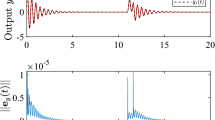Abstract
This paper presents a model-based monitoring approach for the estimation of the elevator rail friction forces. This model-based monitoring approach is based on a Linear Parameter Varying (LPV) model of a 1:1 elevator installation, comprising both the mechanical and the electrical subsystems. The Extended Kalman algorithm (EKF) is then employed as an observer for the joint estimation of the elevator LPV states and parameters. Finally, the estimated rail friction forces are evaluated and energy efficiency indicators describing elevator performance during the ride are obtained.
Access this chapter
Tax calculation will be finalised at checkout
Purchases are for personal use only
Similar content being viewed by others
Notes
- 1.
ReBEL is a Matlab toolkit for Sequential Bayesian inference.
References
Kone Q4 financial statement bulleting 2013 (2014). Tech Rep, Kone
Adak MF, Duru N, Duru HT (2013) Elevator simulator design and estimating energy consumption of an elevator system. Energy Build 65:272–280
VDI 4707 (2007) Lifts—energy efficiency. Association of German Engineers
Kang J, Sul S (2000) Vertical-vibration control of elevator using estimated car acceleration feedback compensation. Trans Indus Electron IEEE 47(1):91–99
Isermann R, Munchhof M (2011) Identification of dynamical systems: an introduction with applications. Springer, Verlag
Van Der Merwe R (2004) Sigma-point Kalman filters for probabilistic inference in dynamic state-space models. Ph.D. thesis, Oregon Health & Science University
Andersson S, Söderberg A, Björklund S (2007) Friction models for sliding dry, boundary and mixed lubricated contacts. Tribol Int 40(4):580–587
Zhou Y (1997) Models for an elevator hoistway vertical dynamic system. In Intenational congress on sound and vibration, no. 5, Adelaida, Australia, pp 2673–2680
Grzesiak L M, Tarczewski T, Mandra S (2008) Permanent magnet synchronous servo-drive with state position controller. In Proceedings of power electronics and motion control conference—13th EPE-PEMC, pp 1071–1076
Venu K, Rushikesh C, Rajasekhar V (2013) Design and analysis of DC motor with PID controller—a state space approach. Transac Electr Electron Eng (ITSI-TEEE) 1:11–14
Ogata K (2003) Modern control engineering. Prentice Hall
Zhang XG, Guo KJ, Li HG, Meng G (2008) A new friction model for the slide guide in elevator systems: experimental and theoretical investigations. Proc Inst Mech Eng, Part C J Mech Eng Sci 222(11):2177–2189
Peters R D (1995) Ideal lift kinematics. In Barney GC (ed) The international congress on vertical transportation technologies. Elevcon, Elevator Technology, pp 175–184
Acknowledgments
This work has been supported in part by the project ETORTEK MECOFF, economically supported by The Basque Government under project No. IE13-379. Any opinions, findings and conclusions expressed in this article are those of the authors and do not necessarily reflect the views of funding agencies. The authors also gratefully acknowledge Orona EIC S. Coop. for supporting this research line.
Author information
Authors and Affiliations
Corresponding author
Editor information
Editors and Affiliations
Rights and permissions
Copyright information
© 2016 Springer International Publishing Switzerland
About this paper
Cite this paper
Esteban, E., Salgado, O., Iturrospe, A., Isasa, I. (2016). Model-Based Estimation of Elevator Rail Friction Forces. In: Chaari, F., Zimroz, R., Bartelmus, W., Haddar, M. (eds) Advances in Condition Monitoring of Machinery in Non-Stationary Operations. CMMNO 2014. Applied Condition Monitoring, vol 4. Springer, Cham. https://doi.org/10.1007/978-3-319-20463-5_27
Download citation
DOI: https://doi.org/10.1007/978-3-319-20463-5_27
Published:
Publisher Name: Springer, Cham
Print ISBN: 978-3-319-20462-8
Online ISBN: 978-3-319-20463-5
eBook Packages: EngineeringEngineering (R0)




